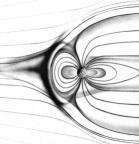Many years ago my dad and my brothers and I would take our telescope out to the back yard during the day and point it at the sun. Holding a white card about a foot away from the eyepiece we would watch sunspots projected on the card, the easily visible evidence of massive solar magnetic storms.
Sometimes we would draw spots on the card where the sunspots were projected and, a few days later, setting up the telescope in the same location, we would see how the sunspots had moved as the solar surface rotated. Not a bad introduction to celestial mechanics!
I was reminded of this by a book I picked up at the public library, Storms from the Sun: The Emerging Science of Space Weather, by Michael Carlowicz and Ramon Lopez, PhD (© 2002, The Joseph Henry Press). This is one fascinating and well written book. It explains with great clarity how the sun and the earth are closely connected via a constant stream of particles that sometimes wreak havoc with terrestrial communications, satellites, and power transmission systems.
Starting with a historic review that shows how scientists gradually pieced together a connection between sunspots, solar flairs, and earthly phenomena such as auroras and disrupted telegraph signals, the authors build a picture of the relationship between the sun and the earth.
The storms referred to in the book's title are not related to rain and snow but to impacts on satellite communications and long distance electrical power transmission via wires, wires that are susceptible to the fluctuations in the earth's magnetic forces when the upper atmosphere is pummelled by particles ejected from the sun.
 The authors point out that the next "peak" in solar storms is expected in 2012, the result in a cycle that averages 11 years from peak to peak as measured beginning in the 1700's. The impacts of this "solar max" event could be quite substantial for all the systems we have that are increasing dependent on power transmission and communications.
The authors point out that the next "peak" in solar storms is expected in 2012, the result in a cycle that averages 11 years from peak to peak as measured beginning in the 1700's. The impacts of this "solar max" event could be quite substantial for all the systems we have that are increasing dependent on power transmission and communications.
Efforts are currently underway, according to this CNN story, to predict the severity of the events expected in 2012. Here is a list of potential impacts from the CNN story; reading the Carlowicz and Lopez book will give you an excellent grounding in understanding these impacts:
- Airlines flying over the pole face loss of communications that could force them to use a different, longer route at an added cost of as much as $100,000 per flight.
- The Global Positioning System is immensely important to commerce and can be disrupted by solar activity.
- Operating floating oil rigs in the ocean requires keeping them positioned within a few inches to prevent damaging drilling gear. "They have to know when GPS is going to be accurate."
- There is an increased radiation risk to humans in space.
- Currents can be induced in long electrical transmission lines, causing blackouts.
To this I would add the potential impacts of solar weather peaks on mobile devices such as cell phones and multimedia devices such as the Apple iPhone with its combination of phone, music, and web features. When inadequately shielded communications satellites get zapped, how many conversations -- and downloads -- will suffer?
- This article has also been published on the SOCIAL MEDIA TODAY web site.



